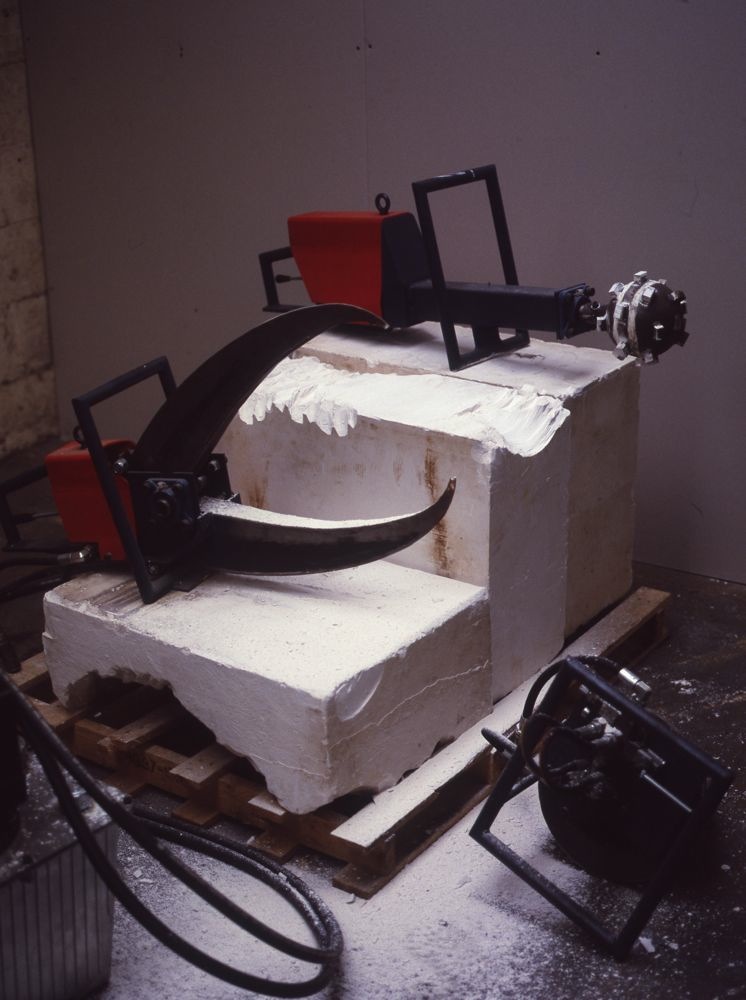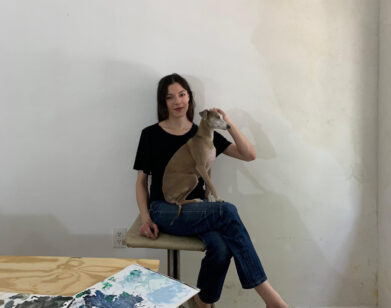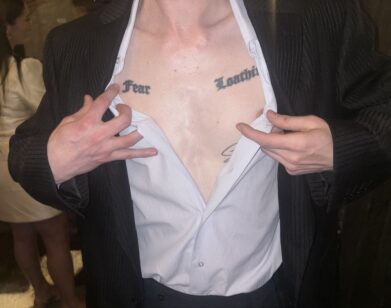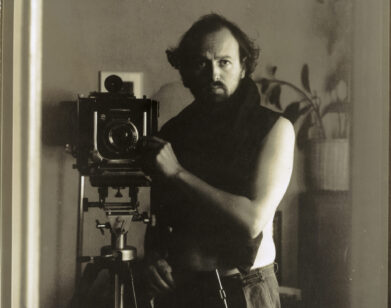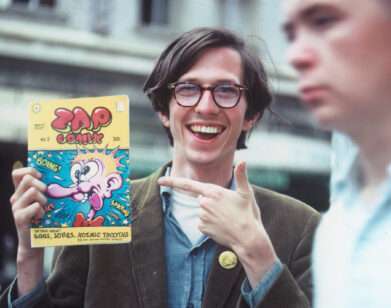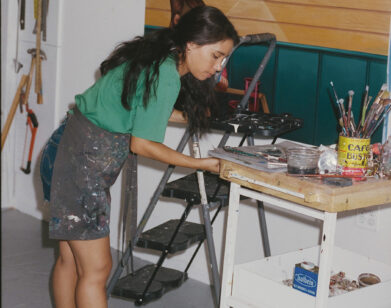The Machinist
In our topsy-turvy world of delegating, outsourcing, and in-house factories, an artist who really gets his hands dirty is something worth noting. One who constructs machines out of steel, sometimes with the assistance of his personal forklift, and then uses complex hydraulic components to bring them to life is even more exceptional. But an artist who creates things that then, in turn, create other things (marks, typically, on the earth’s various surfaces)—that can only be British artist James Capper.
It is not, however, just the mechanics of 26-year-old Capper’s works that makes him one to watch for 2014, rather it is their ability to appeal to a diverse audience in ways that transcend the aesthetic. Take “Tread Toe,” a monstrous yellow beast that walks, which was on view at the Yorkshire Sculpture Park earlier this year. Capper’s demonstrations, in which he brought his creation to life by the push of a pedal, elicited enthusiasm from young children, art enthusiasts, and retired engineers alike. Similarly, when his smaller scale power tools sat on display at London’s Hannah Barry Gallery’s booth at the Armory Show last March, their menacing teeth and implied ability to physically destroy nearby artworks drew throngs of curious fairgoers.
Capper builds his extraordinary artworks in his 2,500 square foot industrial studio in South London. In addition to plans to show at the upcoming Art Basel Hong Kong with Hannah Barry, Capper is working on a long-term project with a private collector and pipeline contractor in Australia (“We get on like a house on fire,” says the affable Capper). The project would ultimately result in a film of one of Capper’s machines going on a lengthy walk across a pipeline excavation in Australia. The proposed project is further evidence that to Capper and his creations, nothing is off limits—be it land, ice, space, sea, or outback.
ALLYSON SHIFFMAN: Where are you?
JAMES CAPPER: I’m in my workshop, just packing up.
SHIFFMAN: What does it look like?
CAPPER: It’s kind of like a factory. It’s full of industrial fabricating machinery: a forklift truck, band saw, ironworker, couple of welders, a load of steel… It’s got an apex roof with windows in it. You’ve got a lot of natural light coming through in the day, compared to a lot of industrial buildings that have the corrugated iron roofs or the concrete roofs that don’t let light in.
SHIFFMAN: Can you recall the first moving machine you ever made?
CAPPER: It was a scooter and I made it down in the cellar at my parent’s place. The first machine that properly moved, with hydraulic systems and so on, is a machine called “Tread Toe.” It kind of walks—it looks like a big yellow cat. It sits out front the studio and reminds people that I’m here.
SHIFFMAN: You don’t need any signage with that out front.
CAPPER: [laughs] No, no. Low profile, but a massive yellow machine.
SHIFFMAN: You’ve mentioned that it was your parents who convinced you to go to art school. Did you have some reluctance to becoming an artist?
CAPPER: [laughs] I said to my mum, “I’ve done my welding apprenticeship. Now I’m going to become a welder.” And she said, “No you’re not, you’re going to art school.” She saved me from being a welder. I have a welder that works next door and he was saying, “It must be interesting when you make something out of steel but then you breathe life into it.” When you turn on the motor the engine on it becomes like a character. My parents met in art school but they didn’t become artists. My dad’s more interested in renovating houses. From a young age [my father] educated me in making things and believing that something could be made with your own hands, which is a very hard thing to convince anyone at any age. Art school educated me about how galleries and all of this other stuff works.
SHIFFMAN: It seems like your philosophy is the exact opposite of someone who delegates work, like a Jeff Koons.
CAPPER: I’ve got a lot of respect for guys that can delegate—that’s quite an incredible skill. The tables have turned—now the builder is considered a bit trashy and the guy that has things made is considered more sophisticated. I could speak to someone from Caterpillar who makes bulldozers and say, “I want to make a machine walk.” He’d probably do it, but it would kind of look like his idea.
SHIFFMAN: How frequently are conversations about your work technical and how frequently are they aesthetic?
CAPPER: In Yorkshire Sculpture Park there was a field where I had a machine, “Tread Toe,” and I would do a demonstration at one o’clock. All these people would come round to the field and there were lots of kids and families watching and having a great time because they’ve never seen something walk in this ludicrous way. The kids would climb on it and sit in the cab and I would chat about how it’s art and it can affect people and they can all understand. Then, from behind the trees, would come these retired engineers. I ended up speaking about it with them in interesting technical ways and it was as exhilarating as it was to show young people that art is not just something on the wall.
SHIFFMAN: Have you ever injured yourself creating or operating one of your pieces?
CAPPER: Anyone who works with steel knows it’s a pretty tough material. You have to be careful and out of being careful, I think you avoid it. I recently bought a forklift because of my back. I thought, what is it, three grand for a forklift? How much is a spine?
SHIFFMAN: I’m curious about your process. How do you research beforehand? Do you draw things down first or start fiddling around with materials?
CAPPER: Influence comes from all industries. It can be anything from shipbuilding to burying uranium at the bottom of the mine with a radio-controlled dump truck. That then goes into a drawing. At the moment, I have 600 drawings in the chest, but only 12 finished machines in the workshop. With drawing, you’re completely free—you have no financial pressure. I suppose that relates hugely to being an artist rather than an engineer or a draftsman working for a company, which has budgets and mechanisms that would prevent creative thought.
SHIFFMAN: What’s something you’re working on now?
CAPPER: What I’m making now is a machine called “Keys.” It weighs about a half a ton. It’s designed to go across a frozen lake at high speeds and leave marks behind it.
SHIFFMAN: How important is failure to your process?
CAPPER: Massively important. If you don’t fail, you don’t move forward. With a machine, you’ve got to juggle everything— especially on bigger projects where people are saying, “This is going to involve 100,000 lbs and this is how many months you have to make it. And you guys say this eight-ton machine is going to walk out of your studio? Because there’s no way we can get a crane in there to take it out.”
SHIFFMAN: [laughs] The stakes are high!
CAPPER: Yeah. Turning the key, the engine starts off, first lever pulled, and the machine walks into motion and you’re just like, “Thank god.” [laughs] And from that point on you’re constantly developing and learning. I had never seen steel fall into dust from not having the adequate grease on it—you don’t think about things like that. If it takes destroying something to learn how to make it right the next time then it’s never seen as a mistake. A lot of money, but never a mistake—it’s a development.
SHIFFMAN: Do you ever wonder how your work will be perceived as technology advances?
CAPPER: I was thinking about that recently. It’s by no means a one-track road. There might be a problem in the future where I’m like, “Oh shit, I’m stuck on the side of this mountain with this machine and I don’t know how to get it out. But there’s that machine that I made in 2010 that had this long bar on it that acted like a foot. Maybe I could just get one of these guys in a local fabricating shop to help me put one together and I’ll get unhooked from this crevasse.” So I kind of see it like that.
SHIFFMAN: That’s very specific.
CAPPER: We’re on less of a timeline and more of a well-trodden path. I’m talking about fields and acres of ideas. You can just come and find me in the field and I’ll say, “Yeah, that’s an idea over there I made 10 years ago, it’s still valid.”
SHIFFMAN: The idea of a timeline for an artist is pretty flawed because it makes it seem like the earlier work is less important.
CAPPER: Yeah, if you were on a timeline you wouldn’t give a fuck about what you made in the beginning. The problem with having ideas is you constantly have to look after them. It’s not like, “Oh, that would be cool to make. I’m gonna do that.” And then two weeks later saying, “Yeah, it’s kind of shit, but I sold it.” It doesn’t work like that.
SHIFFMAN: Some artists think it does.
CAPPER: You said that. Everything that comes out of the studio has a place in the world. It may be my world, but it’s very important that it was never poorly conceived and there was never compromise taken on it—either financially or physically. It’s part of me and it needs to then fight for itself out there.
For more of our 14 Faces of 2014, click here.

